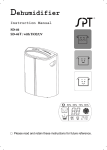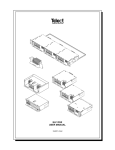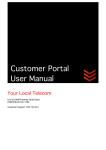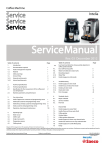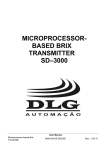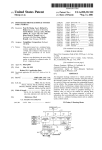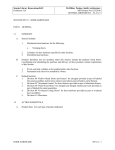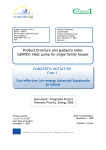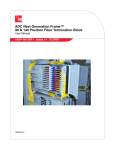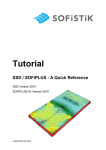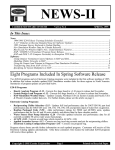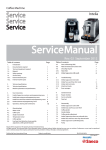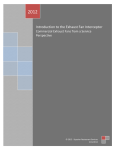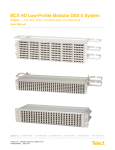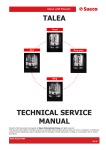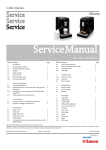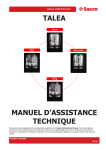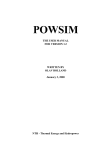Download MODERN PROCESS CONTROLLERS J.R. Allen, Director
Transcript
MODERN PROCESS CONTROLLERS J.R. Allen, Director Sugar Research Institute, Australia SUMMARY Following the discovery of transistors and the subsequent development of solid state technology there have been great improvements in reliability and rapid reductions in the cost of digital data processing equipment. Mini and micro computers are becoming increasingly powerful yet available in smaller packages. Processorbased controllers-have become an essential part of modern control and instrumentation systems and are progressively replacing the traditional pneumatic controllers which were more prone to wear and costly to maintain. Digital processing equipment has much greater capability and flexibility than the outmoded pneumatic controllers. These digital equipments can be built economically to control a large range of plant sizes and complexities. They can control switching (on/off) functions and analoque functions, perform mathematical and logical manipulations of signals, memorise and reproduce past signal trends. Larger systems should be developed progressively from many controllers distributed throughout the plant, each able to control its designated set of machines, and also able to communicate with supervisory control computers. Increased plant efficiency is possible with process control computers, provided that suitable software is available. The writing of the software (programming the computer) is the most critical part in the success of a control installation. A well engineered plant requires less complex control systems to ensure its efficient operation. Modern process controllers have inherent capacity for optimising plant operation. INTRODUCTION Twenty five years ago almost all control and instrumentation equipment was mechanical, and had moving parts with pneumatic, hydraulic or electromagnetic actuation. A good deal of skill was required to manufacture the equipment and to maintai'n it in working order. Little formal training was needed to make the instruments work, because their principles and action were self evident. There was little scope for interaction between control loops and for building complete control systems consisting of many interactive circuits. SOLID STATE DEVELOPMENTS In the early 1960's, transistors and integrated circuits became a practicality. The new hardware, although at first expensive, promised to become progressively 1060 cheaper as it became mass-produced in larger and larger quantities. Furthermore, the equipment could operate with great speed, and, after an initial settling down, was highly reliable. There were no moving parts, there was no wear. Provided the equipment was kept reasonably cool and safe from chemical and mechanical damage, it would have a very long life. Solid state controllers started to appear on the instrumentation market in the early seventies. Initially they were designed to simply replace the pneumatic or electro-mechanical equipment with physically smaller units that required less maintenance. The early electronic equipment consisted of analogue amplifiers and .comparators virtually mimicking the pneumatic and electromechanical functions. At first, solid state technology had far more impact on communication and computing than on instrumentation and control. DIGITAL PROCESSORS (COMPUTERS) Digital computers had been known for many years, but before the advent of solid state technology, their use was confined to complex research and military applications. They were too costly to use for process control in factories. Now as then, every digital processor (or "computer") consists of a Central Processing Unit (CPU), memory and a data highway now called a "bus". The "bus" is also connected to all input and output (1.0.) lines that link the computer with the outside world. The arrangemet characteristic of a digital computer is shown in Figure 1. PARALLEL 1.0. PORT 1.0 BUFFERS FIGURE 1. Essential components of a digital processor. Typical microprocessors have data bus of eight lines (bits) and address bus of 16 lines (bits). The CPU can load data (numbers) from memory or from devices like keyboards ensors (e.g. pressure, flow, temperature), it can perform arithmetical or logical eration on the numbers, and store the result in memory for later use or send it an output device, e.g. a video screen, a printer a motor switch or a valve positioner. 1965, the electronic circuitry needed to make a minimum working system that consists of a CPU, a memory and a bus (and is therefore a "computer"), was to expensive to warrant using such Systems to replace process controllers. Solid state technology developed rapidly, and prices of electronic devices fell so fast, that by 1970 the cost of a small computer system no longer represented too large an overhead on control equipment, provided it could be spread between several control loops. Very soon, the centralised control computers began to appear in factories. These will be discussed later. The downward trend in solid state prices continued, computers became quite cheap compared with the peripheral equipment needed to interface them with factories. Names such as "minicomputer", "microcomputer", "microprocessor" are now used to describe computers that are small in size, but easily capable of performing control tasks. Functions such as memory, timing, amplication, logic (Bollean algebra), decision (level comparison), arithmetic, all became easy to implement with the new generation of computers (mini- or micro-). A small CPU system is now so inexpensive, that a single loop controller can be replaced by a processor-based piece of hardware at a cost below that of a pneumatic controller. The new equipment can perform many functions inexpensively, quickly and reliably. There is, therefore, the capability to build highly sophisticated control systems. Completely different systems, performing different functions can be implemented with the same hardware differently programmed. For example, the same type of programmable logic controller used for tip and weighbridge control in one sugar mill, might be seen controlling centrifugals in another, and a rock crusher in a cement factory. Some simple precautions must be observed when installing the new, solid state equipment in factories. The electronic circuitry cannot survive temperatures in excess of 50 degrees celsius, and is easily damaged chemically (by dirt) or mechanically (by vibration or impact). Therefore, the circuit boards must be protected by housing them in dust and waterproof enclosures. Bigger units should be housed in an airconditioned control room. Some computers (mainly the larger ones) have data storage on magnetic disc (floppy or hard), and the disc drives are easily damaged by dust. Disc (and diskette) drives must be accommodated in clean, dust-free, airconditioned rooms. Provisions must be made for manual back-up so that a human operator can take over control temporarily in the event of electronic failure or if changes are to be made to the control program. The solid state processors have no moving parts and this is an advantage, because there is no failure due to wear. However this also means that an instrument technician cannot deduce from observation of the controller's mechanism what is happening, why the controller does, or does not work. If a technician is to install, commission, and repair the equipment, he needs to have specialised service equipment (oscilloscopes, signal generators, logic analysers etc), and he needs formal training. Electro-magnetic interference (EMI) can be a problem in digital computers of all sizes. Early computers built with transistor-transistor logic (TTL) were easily disturbed by switching transients from relays, solenoids and thyristors. There is always plenty of electromagnetic noise in a sugar mill, and a great deal of time and money have been spent making the new equipment electro-magnetically compatible. Recent industrial equipment is not built with TTL, but mostly C-MOS (complementary metal oxide semiconductor) technology which is inherently far less sensitive to noise. In addition, power supply filters have become commonplace. The input and output connections to the computer are commonly made with optically coupled devices to eliminate direct connection between the computer and the electrical equipment in the factory. Sudden unpredictable behaviour by the control equipment is far less frequently encountered in modern computers than it was in the mid-seventies, but it may still occur, and one always has to allow for the possibility that an improved mains filter, or uninterruptible power supply (UPS), or input/output screening may have to be fitted before the new computer can be trusted to control machinery reliably. Again, to be able to trace such malfunctions, the commissioning technician must be well trained, and must have adequate test equipment. The drawbacks described above are only a small price to pay for the almost complete freedom from routine maintenance of the electronic equipment, and for the great versatility that digital processor-based controllers offer. They can perform switching (on-off) functions that have traditionally been done with banks of relays, and they can also implement complex analogue functions with arithmetic performed on process variables, making the variables interact with one another, and making variables from a previous event influence the current programme. For example, a micro-computer-based controller can be made to boil massecuite in a pan rapidly or slowly, depending on the availability of steam, syrup, or receiver capacity. It can also lower the density control (conductivity) set point as each strike progresses, to compensate for the increasing volume of the massecuite in the pan. This is called conductivity ramping, and is illustrated in the graph shown in Figure 2. A microcomputer can also store all the information about the strike so that the following strike programme can be modified to make it more efficient. This kind of strategy is called adaptive control. The benefits that can be derived from such sophisticated control systems are largely limited only by the programmer's ability to devise the software (the program) that fully utilises the capabilities of the hardware. This is a challenge for both the chemical engineer and the control engineer. CONTROL ENGINEERING Note that it is now the engineer, not the instrument fitter that is neeaed to make the control equipment work. That challenge is often taken personally. Many employees in sugar mills, as in other industries, spend countless hours of their own leisure time writing software that enables ever more clever, cunning, efficient and ambitious control schemes to be implemented. This is satisfying to those highly skilled, highly motivated individuals, and it benefits their employers, but it makes 1063 CRY.CONT. FRACTION ______------.._ .-----_____----_----------------.---------- ,,,*,"-.,,,.pg\A," ----------.-----.---------------------------------OVERSATURATION ME OF BOILING h FIGURE 2. Optimum ramping of conductivity set point for A B strike. it difficult to attempt the reliable costing of the change from the traditional to the new instrumentation. The costs of manufacturing the old-style pneumatic or electro-mechanical instruments have risen considerably, and the equivalent electronic instrumentation is now far cheaper. The change to the solid-state equipment is therefore inevitable. Almost all electronic control equipment that is sold nowadays is based on the computer concept. It consists of a CPU, memory and a data bus. A distinction is often made between "analogue controllers" which can sense and control analogue signals such as'pressure, temperature, position, speed, level etc., (even though internally they operate as digital computers), and "programmable logic controllers" which are used for on-off, switching operations such as sequencing, timing, interlocking etc. The latter are sometimes called "programmable controllers" (PCs or PLCs) or "logic controllers", or "digital controllers". Internally, they are also digital computers. The "analogue" controllers have analogue-to-digital (A/D) and digitalto-analogue (D/A) converters at their inputs and outputs (IOs), the PLCs do not. Instead, they usually have more rugged opto-isolation and mains power switching capabilities at their 10s. COMMUNICATION The digital processor-based equipment has brought with it into the factory a new concept, communication between machines. Most processors have the capability to send data (strings of numbers and characters) on a serial line rather like a Morsecode telegraph. They can also receive messages in the same way, and treat the received data as commands, or information to be used in the processing. This form of communication between machines is different from simple interlocking or crossconnecting of signals in conventional controllers. It allows more complex functions to be performed, historical data to be stored or programs to be changed while process is running. Records can be made by digital printers rather than by pen recorders (which are notorious for depositing either too much or not enough ink on the chart). Unfortunately, there are many different standard codes for serial data transmission, and compatibility of equipment can be a problem. In Australia the terms 'RS232' and "ASCII" are often quoted. The description of transmission codes is beyond the scope of this paper. Suffice it to say that "RS232' is only a loose description of the communication channel, and that such details as speed (baud rate), polarity, word length, parity sense, start and stop bit description also need to match before one can hope that one computer will "talk" to another through the serial line. Fortunately, there is some degree of standardisation, and most computers have pre-settable communication options and can be made to communicate with one another. PROGRAMMABLE CONTROL I Sequencing of operations, interlocking of machinery and of events was traditionally done with relay logic. Where the relays are still operating and no added functions are required, there would be little sense in replacing the relays with solid state devices. However, programmable logic controllers are now far cheaper and smaller than the equivalent new relay sets. PLCs come in various sizes, ranging from those with only eight inputs and outputs, to racks of equipment capable of sequencing, timing and co-ordinating the operation of hundreds of contacts. A small PLC costing under US$700 could control a single batch centrifugal, while for approximately three times that amount a PLC can be purchased, capable of spotting, weighing and tipping of tramway trucks with cane, and capable of communicating with other similar controllers via a single co-axial cable that may be hundreds of metres long. One such controller in a group might be operating a central control console and interacting with a human operator. Each part of the factory can thus be controlled by its own PLC, but the whole can be supervised from one central station. Such a distributed control system has the advantage that a malfunction or modification in one part does not affect the rest of the plant. Some PLCs can be connected to a printer via a serial data link and a written record of their activities can be obtained. Simply buying and installing a PLC will not make it perform the required task. It has to be programmed, and this can be expensive. The person writing the program must have a thorough understanding of control principles and of the plant that is to be controlled. He is usually the controls engineer in the sugar mill. now ledge of the PLC and of programming is also required. Sometimes a good program can be written in cooperation between a hired PLC expert and mill staff. However, expertise in programming PLCs can be acquired in a few hours by an engineer (or technician), given the user's manual for the PLC, the programming device and the ~ L itself, C and freedom from other duties. The design and writing of the actual program takes longer. Usually a program can be written in a few days, and a few more days are needed to "de-bug" it (to make it do the job well). If progress with a program is not evident in a few days, the job is probably being attempted by the wrong person. PLCs have a further advantage over relay sets in the ease with which their programs can be changed. There is no need to re-wire anything if interlock or sequencing logic is to be changed. A few keystrokes on the programming keyboard can add or change a timer, or modify a sequence. Experience in Australia shows that PLCs are introduced into sugar mills without serious problems. It is necessary to ensure that the PLC being bought has a user's manual written (not just translated) in the language that the prospective programmer understands. There are some excellent controllers that are sold to unsuspecting customers with handbooks that have been translated into what looks like English, but is virtually unintelligible and full of technical ambiguities. No doubt in other languages there are similar problems. Despite their ease of programming, ease of installation and simple apperance, , PLCs are not simple to repair because they are in fact small computer systems, and servicing them requires the same equipment and system knowledge as servicing computers. Fortunately solid state equipment, once working, seldom breaks down. Most PLCs are arranged so that individual modules or boards can be replaced by relatively unskilled people with no real knowledge of computers or electronics. In most cases this can remedy the fault. Sugar mills are often located a long way from cities where the electronics experts are, and it is good practice to keep spares at the mill. It is as well to rotate the stock of spares when convenient, because faults in electronic circuitry do not develop as a result of wear, and the spare on the shelf is almost as likely to develop a fault as the working unit. ANALOGUECONTROL I Analogue control is a more complex subject. The traditional PID (proportional/ integral/derivative) controller can be replaced with its modern electronic counterpart for about the price of the old instrument. As mentioned above, many of the single loop so-called analogue controllers nowadays are in fact small digital computer systems with A/D and D/A converters at their 10s. They offer facilities far beyond what could have ever been dreamt of in their pneumatic ancestom. In addition to the PID functions, they offer to the programming control engineer a set of algorithms from which to assemble the best control program. The menu usually includes cascading of set points, mathematical manipulation of the control variables, smoothing functions with root-mean-square or average weighting, bumpless transfer from manual to automatic control. Waiting periods (as opposed to signal integration) may be included in the program, and the controller can be self-tuning (i.e. able to changes its gain and time constant with adaptive control algorithms) so as to always operate close to critical damping of the feedback loop. The chosen selection of control functions can be programmed into the uniJ from a small keyboard. 1066 Large processor-based control systems also have those and many more choices of program modules. In addition, they can perform o sense on/off switch inputs. Thus, they combine anal CENTRAL PROCESS CONT Early computer-ba ne central computer which contained all the program and control circuitry, and all actuators and sensors throughout the factory were wired to that central computer. Figure 3 illustrates such an installation. The central control room looked impressive, VIDEO DISPLAYS PROGRAMMING CONSOLES PLOTTER OR PRINTER 10 INTERFACE FIGURE 3. An e x a m p l e ' o f a centralised control system. and if everything that was supposed to happen happened, the resulting control was very efficient. However, the large amount of wiring made the installations unreliable. In the event of a malfunction in the central computer (and the early computers did malfunction, particularly when they were first delivered), the whole system was severely affected. Despite the high prices and elegant appearance of those early computer installations, they did not offer great advantage over the traditional instrumentation. As mentioned previously, CPUs and memory systems, became progressively cheaper and by the beginning of this decade, one computer could be dedicated to running just a few control loops. Each such local controller can communicate via a high speed digital data link with other local control stations and also with a supervisory station. This is calle shown in Figure 4 The supervisory station is similar i of the seventies, 1067 4 PROGRAM CONSOLE ~~~~~ STRATEGIC PROCESS MIMIC DISPLAY SUPERVISION COMPUTER ..:..: .'...< .'. 2 . : FIGURE 4. Example of a distributed hierarchical control installation. independently. The function of the supervisory station is to display to human operators in a convenient format what is going on throughout the plant, and to occasionally modify the programs of the local controllers by adjusting set points, time constants and the like. A computer fault in such a system affects one station only, and the consequences are no worse than a malfunction of a few traditional single loop controllers. All the sophisticated control functions can be implemented by the distributed contl;ollers. The supervisory station can be equipped with colour displays on cathode ray tubes, showing mimic diagrams of the factory, with the current status of the actuators, sensors, levels etc. Trends i.e. graphs of the history of each control quantity can be displayed, or down-loaded to a printer or tape or disk. A typical print-out of trend graphs a milling train is shown in Figure 5. The ability to drive a digital printer directly from the process computer also means that diagrams of control schematics and of algorithms that have been entered into the computer can be readily printed out. This saves drafting costs and yields correct up-to-date control system records in a standardised form. An example of a printed record is shown in Figure 6. Once a digital control system is operating it offers scope for optimising the operation of the plant. Unlike human operators, computers do not suffer from boredom or fatigue. Therefore, plant control is of a uniform standard. In the event of a mechanical failure or accident in the factory, the damage is minimised because the shut-down action can be orderly, yet very rapid,,compared with the action taken \t 4837.9 RPI~1 8.80 I IW ILL TURQUE 188.88 67.53 % 0 .EIB CTClRPLlE HCI .6 IIIM ILL TORCIIIE 100.08 4 9 1 I i , 8 . 88 1 FIGURE 5. Trend print-out from a milling train. ESJ - PRE. EVAPORATER Tn ESJ TANK 34.7 % PRE EVAPORATOR CONDENSATE PUMP TO WEST EFFETS TRANSFER PUMP PRE EVAPORATOR ESJ PUMPS ESJ PUMPS OPEN H CLOSED FIGURE 6. Control system documentation obtained from a control computer via a digital printer. by human operators in a time of panic. The advantages of such a system are clear to any plant manager. 'INTEGRATING HARDWARE WITH SOFTWARE Processor-based controllers are offered by a number of electronics and instrurnentation companies. In addition to the ready-made control systems, there are microcomputer systems engineered for "original equipment manufacturers" (OEMs). These are often built around the same microprocessors that the instrumentation companies use in their products. A control system can be built up within a sugar mill by buying an OEM microcomputer from its manufacturer, and either building or buying the peripheral input and output circuitry. There are examples of both types of control system in Australia. The hardware for modern digital control is readily available from several reputable suppliers. However, the system can only function effectively if it is complemented by appropriate software. Unfortunately, the software most suited to a sugar mill's individual needs cannot be bought readily. It must be written by someone with a good understanding of the particular plant. That someone is frequently called a "systems engineer". He must be competent at programming and control theory, but at the same time he must not become distracted by the pretty coloured pictures which he can create on screens and lose sight of the real objectives. Averaged values are not always adequate, and it is important that the operator knows when an actuator is driven from end to end, rapidly alternating between open shut while simply maintaining what is being recorded as an average value. It is imperative to be able to control and monitor in such a way that an indication is obtained of the real performance of the plant. There are installations where fundamentals are being ignored (such as effective capacity of surge tanks) and these are not always obvious from the displays available. DESIGN OF PLANT The ability of the processor-based control system to perform complex functions is no substitute for designing the plant correctly at the outset. Attention must be paid to such things as correct pipe sizes, valve sizes and tank sizes. For proper control it is most unlikely that a lOOmm valve will be appropriate for a lOOmm pipeline. A widely fluctuating flow in a pipeline can be handled by the installation of a surge tank. The surge tank must not be controlled to operate within close limits at a chosen level, but must be allowed to operate over a wide range of levels, otherwise there is no point in having a surge tank. Similarly, it is possible to live dangerously with very small drums in a boiler, or relax with larger capacity drums which have much more docile characteristics. PROGRAMMING CONTROL COMPUTERS This is done in one of a variety of "control languages" and usually includes a menu of ready-made control subroutines that can be called up with a single instruc- tion. Some control systems require the programmer to create a graphic representation of the control (rather than a sequential list of instructions). The record of such a program is in the form of a diagram rather than the familiar computer program listing. An example of a program for a PID controller is shown in Figure 7. &FJkT (MT061 I NO 1 MlLL TURBINE SPEED CONTROL C-F TRANSFER TO (MT052 L- - - - - - -- - - - - - - - - - - ---a NO. 1 MlLL TURBINE SPEEQ CONTROL FIGURE 7. The print-out of a program for a P.I.D. loop "control language". If there is no suitable person in a mill to write the programs, a consultant must be engaged, this would be expensive, and there is considerable risk that the program will not do what is wanted. A further important factor in the program development is that the program should be fully documented. Wherever possible, the programming should be done by a team of people who interact with one another. A disadvantage of the computer control system is that repairs to the computer and its electronic hardware are seldom feasible within the mill. The servicing of computers requires specialised personnel and equipment and the expense of maintaining them in a sugar mill is not warranted. All that was said above about the PLC can also be said about the control computer hardware. To have a reliable system, it is necessary to keep a set of spares locally, and to deal with a supplier who has a known and proven record of reliability of service. FINAL ACTUATORS ave been in use for some time, many I of the actuators and sensors required for control are already in place and the cost of introducing computer control is mainly composed of the cost of the electronic hardware, a little wiring and of the writing of the sofware and operator training. For factories where there is little automation and the introduction of computer control is being considered, the cost is much higher, Such factories would also be 1071 further disadvantaged by having no staff already familiar with plant automation. In particular, it is often necessary to retain existing pneumatic actuators, and to ,perate them from the electronic equipment by using current to pneumatic (UP) converters. Similarly, some rexisting pneumatic signal transducers are retained by ,using suitable pneumatic to current (P/I) converters. The cost of the electrically operated valves, the position'controllers, the actuators and sensors with their wiring and installation is far greater than that of the computers and of the programs, conversion has to make the best use of the equipment already in place. However, the distributed control system (DCS) has the advantage that it can be,introduced INTRODUCTIO NTROL SYSTEM A distributed control system is far less costly and easier to introduce into a factory than the centralised computer system of the seventies. For example, a start may be made with just one pan being controlled by one local control station. Figure 8 shows diagrammatically the arrangement of automatic control valves that would enable a control computer to operate a vacuum pan. Later the station can be made to control a few more pans, and the additional software can be written progressively as more wiring, actuators and sensors are installed or converted. The pan control could progress from simple feed and vacuum control to full sequence control of -------- -- CONDENSER VACUUM PAN MOLASSES CUT-OVER r '*IN ' CUT 0 'VER LINE \ DISCHARGE FIGURE 8. Valving scheme for a sugar vacuum pan. further disadvantaged by having no staff already familiar with plant automation. In particular, it is often necessary to retain existing pneumatic actuators, and to operate them from the electronic equipment by using current to pneumatic (I/P) converters. Similarly, someaexistingpneumatic signal transducers are retained by ,using suitable pneumatic to current (PA) converters. The cost of the electrically operated valves, the position controllers, the actuators and sensors,with their wiring and installation is far greater than that of the computers and of the programs, conversion has to make the best use of the equipment already in place, However, the distributed control system (DCS) has the advantage that it can be.introduced INTRODUCTIO NTROL SYSTEM A distributed control system is far less costly and easier to introduce into a I factory than the centralised computer system of the seventies. For example, a start may be made with just one pan being controlled by one local control station. Figure 8 shows diagrammatically the arrangement of automatic control valves that would enable a control computer to operate a vacuum pan. Later the station can be made to control a few more pans, and the additional software can be written progressively as more wiring, actuators and sensors are installed or converted. The pan control qould progress from simple feed and vacuum control to full sequence control of INJECTION WATER 2 VACUUM I -------- -- CONDENSER VACUUM PAN 35-150rn3 STEAMOUT 1 STEAM WATER- -CUT-OVER \P OVER C U T- \? DRAIN DISCHARGE FIGURE 8. Valving scheme for a sugar vacuum pan. I ~ the pan turn-around, and even to control of cut-over operations and supervisory control of pan boiling rate. Then another station might be installed to control the seven analogue loops on the evaporators, then another for the milling train or diffuser. Eventually a supervisory station and a central control room might be built. This all takes several years, and hardware, software and expertise all accumulate gradually. In Australia there are several sugar mills with distributed computer control systems installed and operating, and each year the systems expand progressively to inclue more and more of the factory, or to incorporate some new feature of the hardware or software. PERSONAL COMPUTERS The progress in computer technology that has brought about the distributed control system is still continuing and already there are signs that yet another form of computer controller is on the way. Personal computers were originally the smallest of the "micro-computers". They are now so powerful that they can easily handle programs of the size and complexity required for plant control. Their prices are far below those of the processor-based industrial control systems, but they lack the ruggedness needed in the factory environment, and have to be programmed in a computer rather than a control language. Nevertheless, personal computers are being used increasingly for control, are now appearing in a ruggedised industrial form and require accommodation similar to that for control computers. They need to be fitted with optically isolated interface modules to enable them to sense and actuate machinery, and the programs are being written in BASIC, FORTH, PASCAL or one of the other standard computer languages rather than a "shorthand" control language. BASIC is taught at schools and universities and there are many people who are already proficient at writing BASIC software. The extra time needed to write control subroutines in BASIC may be offset by the fact that there is no need for the programmer to learn yet another language that suits the control computer. In Australia there are at least two examples of this new art. One is in juice sampling, the other is in controlling of a photoperiod facility for use in cane plant breeding. CONCLUSIONS Digital processor-based control systems are no more expensive than traditional pneumatic controllers. They are more versatile than traditional controllers, are virtually maintenance-free and give better over-all plant control and improved performance. Introduction of digital control is best done by progressive installation of a distributed system in which some of the existing automation equipment can be retained. Processor-based control can be introduced effectively where mill staff or consultants are capable of writing the control programs and installing the equipment. It is appropriate to commence conversion to modern process controllers when modifications are being made to plant or control equipment and/or when improved performance of plant is required. ! ' I I , 1 ,
















